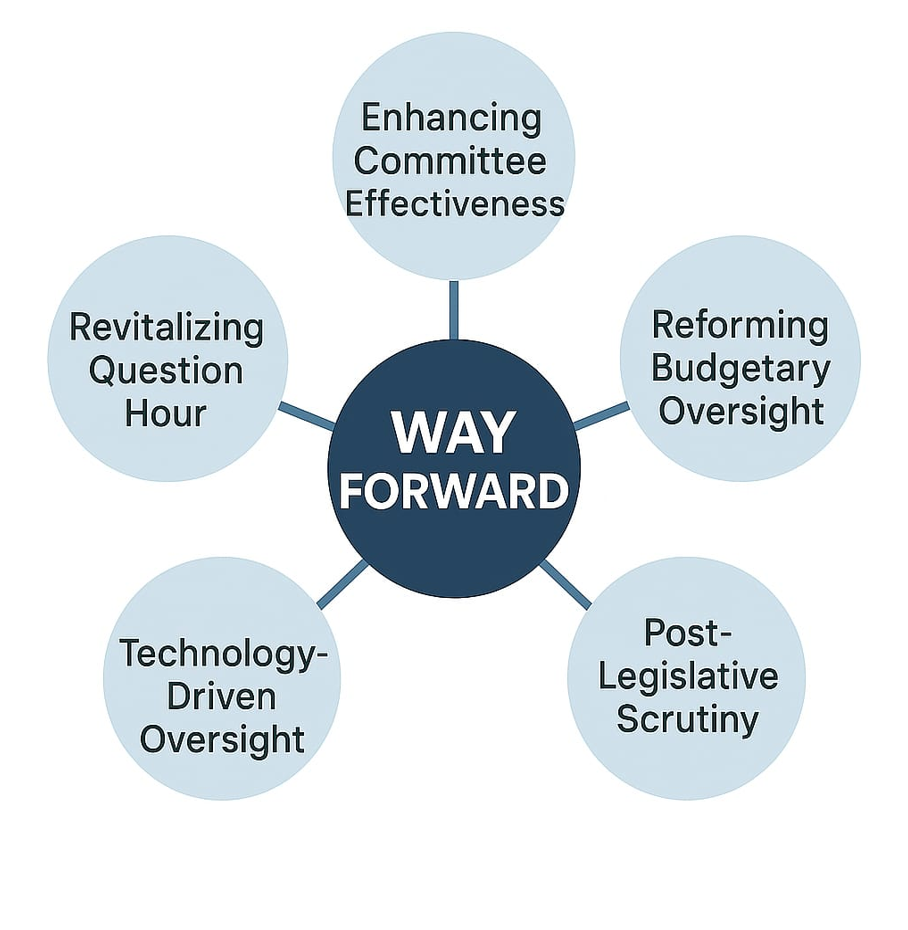There are no items in your cart
Add More
Add More
| Item Details | Price | ||
|---|---|---|---|
Mon Jun 30, 2025
పరిచయం:
డాక్టర్ బి.ఆర్. అంబేద్కర్ పార్లమెంటరీ వ్యవస్థను గట్టిగా సమర్థించారు. స్థిరత్వం మరియు జవాబుదారీతనం మధ్య సమతుల్యతను సాధించే సామర్థ్యం అనేది ఒక శక్తివంతమైన ప్రజాస్వామ్యానికి అవసరమైన అంశాలుగా గుర్తించారు. ఇది కార్యనిర్వాహక అధికారాన్ని నియంత్రించడానికి కీలకమైన విధానంగా నిలిచింది.
విషయం:
కార్యనిర్వాహక శాఖ యొక్క జవాబుదారీతనాన్ని నిర్ధారించే సంస్థాగత విధానాలు
1. ప్రశ్నోత్తర సమయం
a. ఎంపీలు పరిపాలన, విధానాలు మరియు వ్యయాలపై మంత్రులను నేరుగా ప్రశ్నలు అడుగుతారు.
b. ఉదాహరణ: పీఎంఎవై, ఎన్ఆర్ఇజీఎస్, రక్షణ కొనుగోళ్ల వంటి పథకాలపై ఎంపీలు అడిగిన ప్రశ్నలకు, కార్యనిర్వాహకులు తమ చర్యలను స్పష్టం చేయవలసి వచ్చింది.
2. జీరో అవర్
a. ఇది భారతీయ ఆవిష్కరణ, ఎంపీలు ముందస్తు నోటీసు లేకుండా అత్యవసర ప్రజా సమస్యలను లేవనెత్తడానికి వీలు కల్పిస్తుంది. తక్షణ స్పందనలను బలోపేతం చేస్తుంది.
b. ఉదాహరణ: ధరల పెరుగుదల, కుల హింస, సహజ విపత్తుల వంటి సమస్యలను ఎంపీలు లేవనెత్తారు.
3. స్థాయి కమిటీలు (విభాగాలకు సంబంధించిన స్థాయి కమిటీలు – డీఆర్ఎస్సీలు)
a. మంత్రిత్వ శాఖల బిల్లులు, బడ్జెట్లు, విధానాలను వివరంగా పరిశీలిస్తాయి.
b. ఉదాహరణ: రైల్వే కమిటీ 2015లో డివిడెండ్ చెల్లింపులను మాఫీ చేయాలని సూచించింది. రైల్వే ఆర్థిక స్థితిని మెరుగుపరిచేందుకు ఇది అమలు చేయబడింది.
4. పబ్లిక్ అకౌంట్స్ కమిటీ (పీఏసీ)
a. సీఏజీ నివేదికలను, ప్రభుత్వ వ్యయాన్ని పరిశీలించి, ప్రజా నిధుల సమర్థవంతమైన వినియోగాన్ని తెలియజేస్తుంది.
b. ఉదాహరణ: 2010 కామన్వెల్త్ గేమ్స్లో అవినీతిని బయటపెట్టి, సంస్కరణలకు దారితీసింది.
5. అంచనా కమిటీ
a. బడ్జెట్ కేటాయింపులు, వ్యయ సమర్థత, విధానాల అమలు సామర్థ్యాన్ని అంచనా వేస్తుంది.
b. ఆర్థిక క్రమశిక్షణ మరియు ఫలితాల ఆధారిత వ్యయాన్ని నిర్ధారించడానికి సహాయపడుతుంది.
6. అవిశ్వాస తీర్మానం (ఆర్టికల్ 75(3))
a. ప్రభుత్వ మెజారిటీని పరీక్షించడానికి, సామూహిక జవాబుదారీతనాన్ని అమలు చేయడానికి నేరుగా ఉపయోగపడే సాధనం. b. విజయవంతం కాకపోయినప్పటికీ, ఇది దేశవ్యాప్తంగా కార్యనిర్వాహక చర్యల పరిశీలనను ప్రేరేపిస్తుంది.
7. శాసన విధానాలు(107–111అధికరణలు)
a. బిల్లుల పరిశీలన, ఉభయ సభల సమావేశాలు (ఆర్టికల్ 108), రాష్ట్రపతి ఆమోదం/సూచనల కోసం నిబంధనలు, కార్యనిర్వాహక బిల్లులపై విధానపరమైన తనిఖీలను తెలియజేస్తుంది.
8. బడ్జెట్ పర్యవేక్షణ (ఆర్టికల్స్ 112–117)
a. వార్షిక ఆర్థిక ప్రకటన (బడ్జెట్) మరియు మనీ బిల్లులకు పార్లమెంట్ ఆమోదం అవసరం, శాసనసభకు ప్రజా వ్యయాన్ని నియంత్రించే అధికారాన్ని ఇస్తుంది.
భారతదేశంలో పార్లమెంటరీ పర్యవేక్షణ:
1. రాజ్యాంగ నిబంధనల ఉన్నప్పటికీ పర్యవేక్షణ బలహీనపడటం
a. రాజ్యాంగం తనిఖీలు మరియు సమతుల్యతను నిర్ధారిస్తునప్పటికీ (ఆర్టికల్స్ 74–75, 107–117), తరచూ అంతరాయాలు, కమిటీలకు తక్కువ సూచనలు, కార్యనిర్వాహక ఆధిపత్యం వల్ల శాసన పర్యవేక్షణ క్షీణించింది.
b. పీఆర్ఎస్ లెజిస్లేటివ్ రీసెర్చ్ ప్రకారం, 17వ లోక్సభలో కేవలం 13% బిల్లులు కమిటీలకు సూచించబడ్డాయి. ఇది 15వ లోక్సభలో 71% కంటే తక్కువ.
2. సామర్థ్యం vs జవాబుదారీతనం
a. పరిపాలనలో వేగం అనేది కీలకం అయినప్పటికీ, పారదర్శకతను త్యాగం చేయకూడదు. “గరిష్ఠ పరిపాలన” కోసం ప్రయత్నం “గరిష్ఠ జవాబుదారీతనం”తో సమతుల్యం కావాలి. దీనికి బలమైన, క్రియాశీల పార్లమెంట్ అవసరం.
3. సమర్థవంతమైన పర్యవేక్షణకు ఉదాహరణలు
a. రైల్వే కమిటీ (2015): భారతీయ రైల్వే డివిడెండ్ చెల్లింపులను మాఫీ చేయాలని సిఫారసు చేసింది, 2016లో అమలు చేయబడి ఆర్థికాభివృద్దిని మెరుగుపరిచింది.
b. పబ్లిక్ అండర్టేకింగ్స్ కమిటీ: ఎన్హెచ్ఏఐ ప్రాజెక్టులకు ముందు 80% భూసేకరణ మరియు క్లియరెన్స్లను సిఫారసు చేసింది. అలాగే అమలు గడువులను వేగవంతం చేసింది.
c. రవాణా కమిటీ (2017): మోటారు వాహన బిల్లులో బీమా పరిమితులను తొలగించడం, జాతీయ రహదారి భద్రతా బోర్డు ఏర్పాటును ప్రభావితం చేసింది.
d. అంచనా కమిటీ: దేశీయ యురేనియం ఉత్పత్తిని పెంచాలని సూచించింది. ఇది శక్తి భద్రతకు సహాయపడింది.
e. పబ్లిక్ అకౌంట్స్ కమిటీ (పీఏసీ):
-2010 కామన్వెల్త్ గేమ్స్లో ఆలస్యం మరియు అపారదర్శక నియామకాలలోని అవినీతిని బయటపెట్టింది.
-సంవత్సరానికి సుమారు 180 సిఫారసులు చేస్తుంది. ఇందులో 80% ఆమోదించబడ్డాయి (లోక్సభ సెక్రటేరియట్,2021)
.కార్యనిర్వాహక పర్యవేక్షణలో పార్లమెంటరీ వ్యవస్థ యొక్క సవాళ్లు
1. ప్రశ్నోత్తర సమయం యొక్క తగ్గుతున్న పాత్ర
a. రోజువారీ కార్యనిర్వాహక పరిశీలనకు మూల స్తంభంగా ఉన్న ప్రశ్నోత్తర సమయానికీ తరచూ అంతరాయం కలుగుతోంది.
b. 17వ లోక్సభలో, లోక్సభలో 60% మరియు రాజ్యసభలో 52% సమయం మాత్రమే ఇది పనిచేసింది.
c. అంతరాయాలు మరియు తగ్గుతున్న ప్రశ్నలు నిరంతర జవాబుదారీతనాన్ని ఉత్పత్తి చేయడంలో పరిమితం చేస్తాయి.
2. పార్లమెంటరీ కమిటీల పరిమిత ప్రభావం
a. డీఆర్ఎస్సీలు వివరణాత్మక నివేదికలను రూపొందిస్తాయి. కానీ వాటి సిఫారసులు శాసన లేదా విధాన నిర్ణయాలను అరుదుగా ప్రభావితం చేస్తాయి.
b. సంప్రదింపులు పరిమిత వైవిధ్యాన్ని కలిగి ఉంటాయి. ఇది సమగ్రత మరియు చట్టబద్ధతమైన ఆందోళనలను లేవనెత్తుతాయి.
3. బడ్జెట్ ప్రక్రియలలో కార్యనిర్వాహక ఆధిపత్యం
a. కేంద్ర ఆర్థిక మంత్రిత్వ శాఖ ఎంపీల నుండి తక్కువ ఇన్పుట్తో బడ్జెట్ను సిద్ధం చేస్తుంది. అలాగే చర్చనీయ సామర్ధ్యాన్ని తగ్గిస్తుంది.
b. మనీ బిల్లులపై రాజ్యసభకు ఓటింగ్ అధికారం లేదు.
4. బలహీనమైన అనుసరణ విధానాలు
a. పీఏసీ లేదా అంచనా కమిటీల నివేదికలకు బైండింగ్ ఫోర్స్ లేదు. అంటే కార్యనిర్వాహకులు వాటి సిఫారసులపై చర్య తీసుకోవలసిన బాధ్యత లేదు.
b. సిఫారసులపై చర్యలను పర్యవేక్షించడానికి నిర్మాణాత్మక వ్యవస్థ కూడా లేదు.
5. ఎంపీలకు సాంకేతిక మద్దతు లేకపోవడం
a. చాలా మంది ఎంపీలకు సంక్లిష్ట విధాన సమస్యలను అర్థవంతంగా పరిశీలించడానికి వృత్తిపరమైన పరిశోధన సిబ్బంది లేదా డేటా అనలిటిక్స్ సాధనాలు అందుబాటులో లేవు.
b. ఇది క్షేత్రస్థాయి చర్చలకు మరియు పక్షపాత వైఖరిని పెంపొందించడం దారితీస్తుంది.

ముగింపు:
బ్రిటన్ యొక్క వెస్ట్మిన్స్టర్ పార్లమెంటరీ విధానాన్ని అమెరికా అధ్యక్ష వ్యవస్థపై ఎంచుకోవడం ద్వారా, భారతదేశం సామూహిక బాధ్యత మరియు నిరంతర శాసన పర్యవేక్షణ ద్వారా బలమైన సమతుల్యతను సంస్థాగతం చేయాలని లక్ష్యంగా పెట్టుకుంది. భారతీయ ప్రజాస్వామ్యం దృఢంగా మరియు స్పందనాత్మకంగా కొనసాగడానికి, పార్లమెంట్ కార్యనిర్వాహక జవాబుదారీతనాన్ని నిర్ధారించే వేదికగా కొనసాగుతూ, స్థిరమైన మరియు ప్రజలకు జవాబుదారీగా ఉండే పరిపాలనను పెంపొందిస్తుంది.